Unleavened Bread Recipe for Communion
Having communion at home can be a wonderful experience for your family. Make this simple and super easy unleavened bread recipe for your own at home communion.

Whether you are simply having a special communion service for your family, or if you are watching your Sunday morning church service from home and want to participate in communion, you’ll want to make this easy communion wafer recipe.

What is unleavened bread?
Unleavened bread is a type of bread that is made without yeast or any other leavening agents that cause the bread to rise. Unleavened bread is typically made with a few basic ingredients such as flour, water, and sometimes salt. While leavened bread uses yeast or another leavening agent such as baking powder or baking soda to rise the bread.
Why use unleavened bread for communion?
The Last Supper, where Jesus and the disciples had the first Eucharist or communion, was a Passover meal.
During the Passover, Jews traditionally eat unleavened bread (called matzo or passover bread) as a reminder of the haste with which the Israelites left Egypt. Using unleavened bread in for communion replicates this passover meal. During that first communion at Passover, Jesus used the unleavened bread to represent his body, which he would give as sacrifice at the crucifiction.
Unleavened bread is also used in communion as a symbol of purity and sinlessness. The absence of leaven, which causes bread to rise through fermentation, is often associated with the absence of impurity or sin. Thus, unleavened bread is used to represent the sinless body of Christ to emphasize the holiness and purity of Jesus.
Does bread have to be unleavened for communion?
It’s important to note that not all Christian denominations require the use unleavened bread for communion. Some Protestant denominations, like Lutherans and Anglicans, may use either leavened or unleavened bread. The specific choice of bread type varies among denominations and can be influenced by theological differences, local customs, or historical practices.
Using unleavened bread during communion allows for a closer similarity to the first communion of Jesus and his disciples. Whether unleavened bread is a requirement for communion comes down to personal belief and often your denomination.
Why make homemade communion wafers?
There are many reasons for a homemade communion bread recipe. Some churches, Sunday School classes, or Bible Study groups may wish to make their own communion bread. This easy recipe makes it easy to make your own unleavened communion wafers.
In my own church we take turns gathering the supplies for communion. Some prefer to buy or order the communion wafers, while others make homemade communion bread.
Many churches are now live streaming their services, and this unleavened bread recipe allows families to easily enjoy communion at home while streaming their religious services.
**This recipe was originally posted during the height of Covid, when many of us could not meet with our churches for services or communion.
What breads are considered unleavened?
The homemade communion bread recipe we share below is unleavened.
But, maybe you’d like to know what other types of breads can also be unleavened, whether to buy a store bought unleavened bread for communion, or to try another type of homemade unleavened bread for your communion.
Of course, if unleavened bread is your goal, be sure to always double check the label! If making a homemade bread be sure to check the recipe for leavening agents (baking soda, baking powder, and yeast).
Breads that are often unleavened:
- Matzo, also spelled matzah or matzoh, is a traditional Jewish unleavened bread. It is typically made from wheat flour and water and is an essential part of the Passover Seder meal.
- Tortillas are a type of unleavened flatbread that is commonly used in Mexican and Central American cuisine. They can be made from corn or wheat flour.
- Chapati, also known as roti in some regions, is a type of unleavened flatbread from India. It is made from whole wheat flour and water, and it is a staple food in Indian cuisine.
- Lavash is a thin, soft, and flexible unleavened flatbread that is popular in Middle Eastern and Mediterranean cuisine. It is made from wheat flour, water, and sometimes a little salt.
- Traditional Pita Bread is made without yeast and is considered unleavened. It is a round, pocket-style bread used in Middle Eastern and Mediterranean dishes. (**some modern store bought pita, and even recipes contain yeast)
- Injera is a type of sourdough unleavened bread that is a staple in Ethiopian and Eritrean cuisine. It is made from teff flour and has a unique, spongy texture.
How to store unleavened bread
This unleavened bread recipe can stay fresh at room temperature for about 2 to 5 days if stored in an airtight container or wrapped tightly in plastic wrap or aluminum foil.
You can store unleavened bread in the freezer. Be sure to allow the bread to cool completely before wrapping it tightly in plastic wrap or aluminum foil. After wrapping the bread, you can place it in an airtight container or a resealable freezer bag for extra protection.
When you’re ready to use the frozen unleavened bread, simply remove it from the freezer and let it thaw at room temperature.

If you’d like to learn how to make your own easy unleavened bread this year, this recipe is for you!
(You’ll find a printable recipe card at the end of this post)
How to make Homemade Unleavened Bread for Communion
Ingredients:
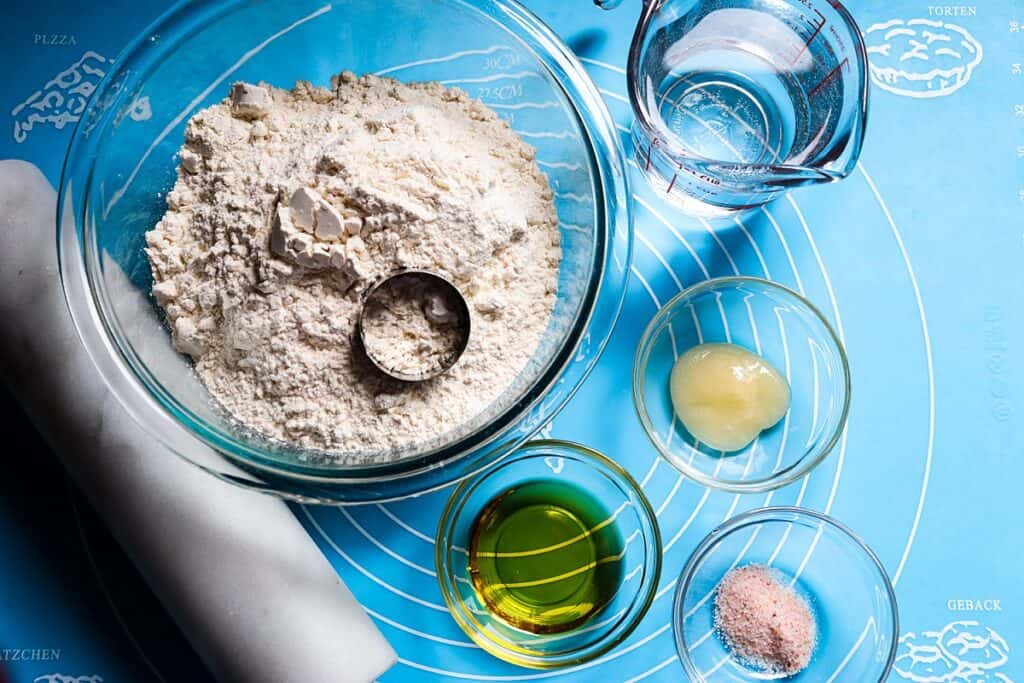
- 3 cups flour
- 1 cup hot water
- 2 tbsp olive oil
- 2 tsp honey
- 1 tsp salt
Additional Items:
- 1 1/2” round cookie cutter
- rolling pin
- fork
Instructions:
Preheat oven to 400°.
Combine ingredients and knead for 3 minutes.
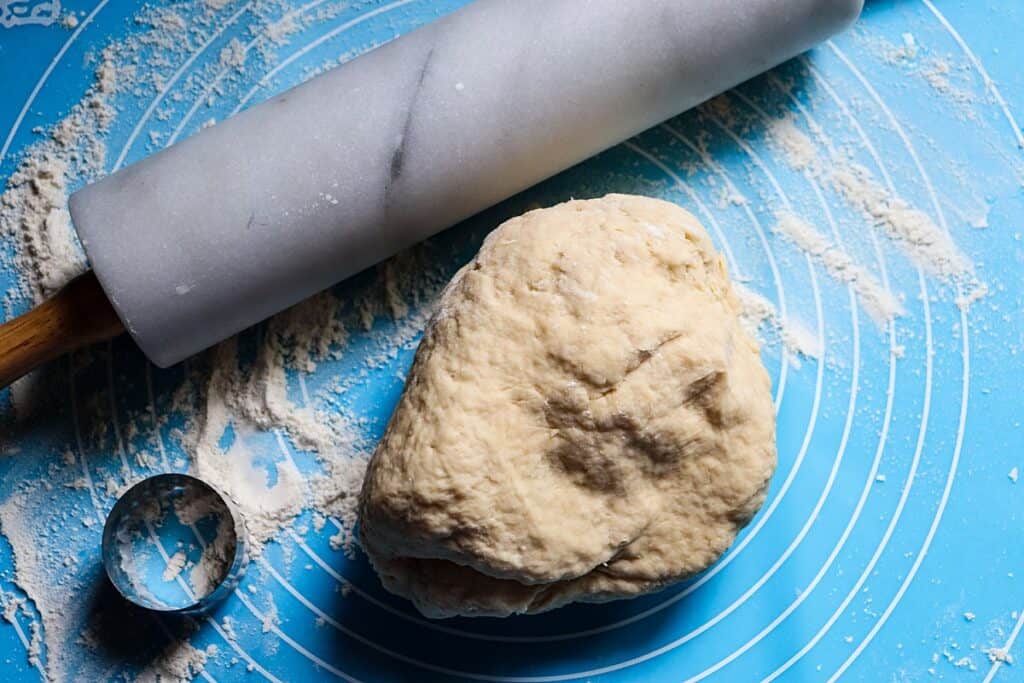
Roll dough to 1/8″ thick.
Cut out circles using a 1 1/2″ cookie cutter.
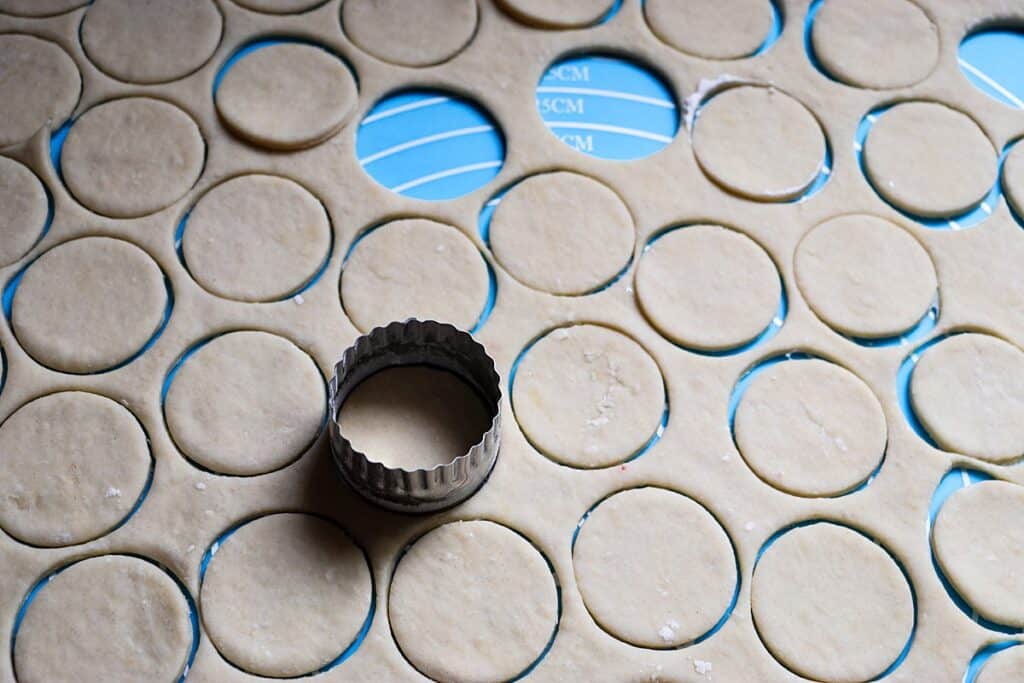
Transfer wafers to baking sheet.
Prick wafers with fork 2 or 3 times each.

Bake at 400° for 5-8 minutes, until just beginning to brown.

Enjoy communion as a family!
*the unleavened bread wafers will keep for 2 weeks in a container on the counter, or you can store them in the freezer to use as needed.

Unleavened Bread Recipe for Communion
Unleavened Bread Recipe
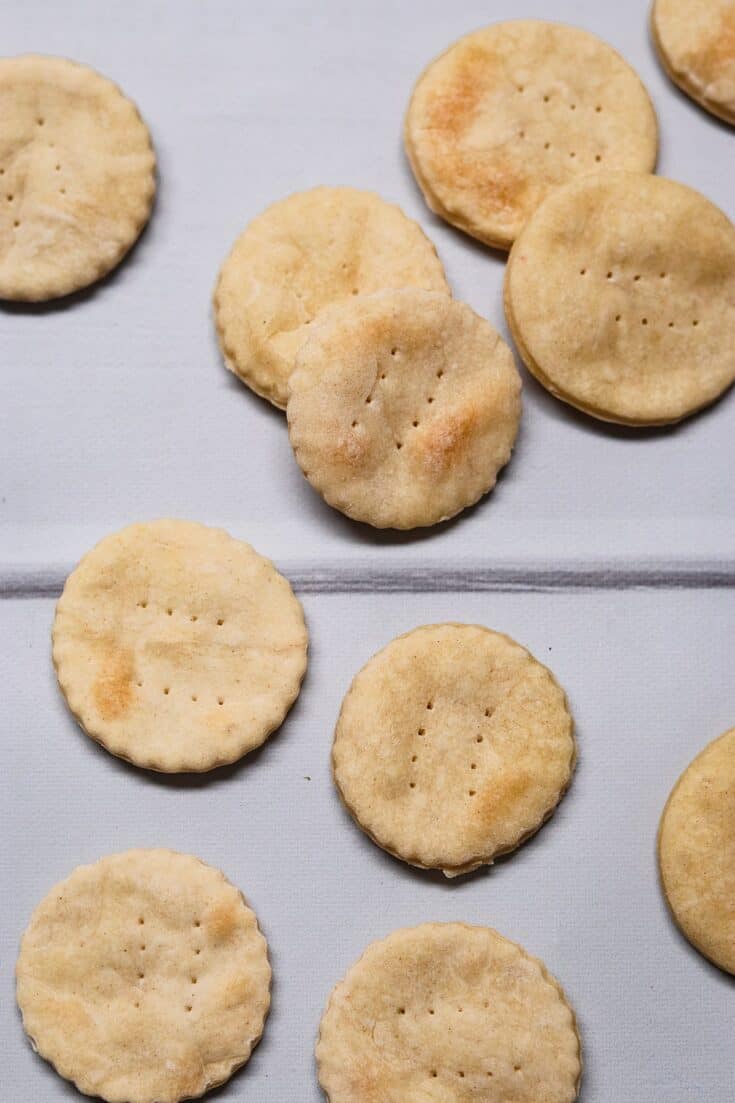
These homemade unleavened wafers are perfect for communtion at home. Make your own unleavened bread for communion!
Ingredients
- 3 cups flour
- 1 cup hot water
- 2 tablespoons olive oil
- 2 teaspoons honey
- 1 teaspoon salt
Instructions
- Combine ingredients and knead for 3 minutes.
- Roll to 1/8" thick.
- Cut out circles.
- Transfer wafers to baking sheet.
- Prick wafers with fork 2-3 times.
- Bake at 400° for 5-8 minutes
- Store 2 weeks or keep in the freezer until needed
Notes
Additional items needed for this recipe:
1 1/2" round cookie cutter
rolling pin
fork
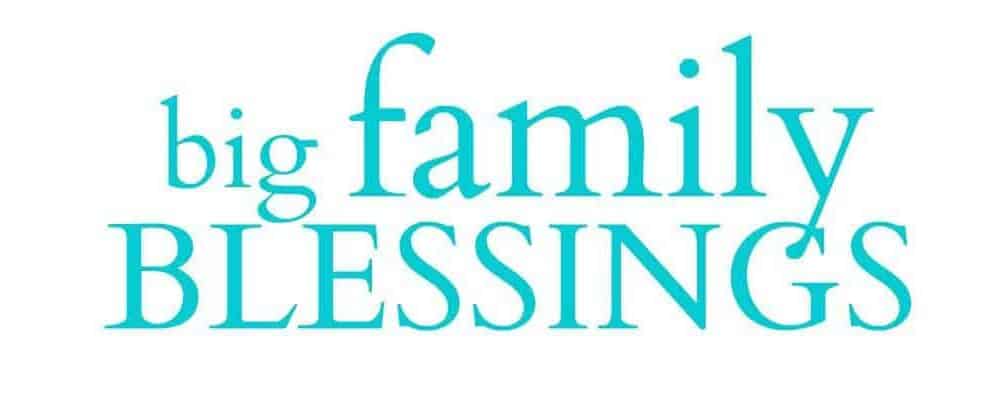

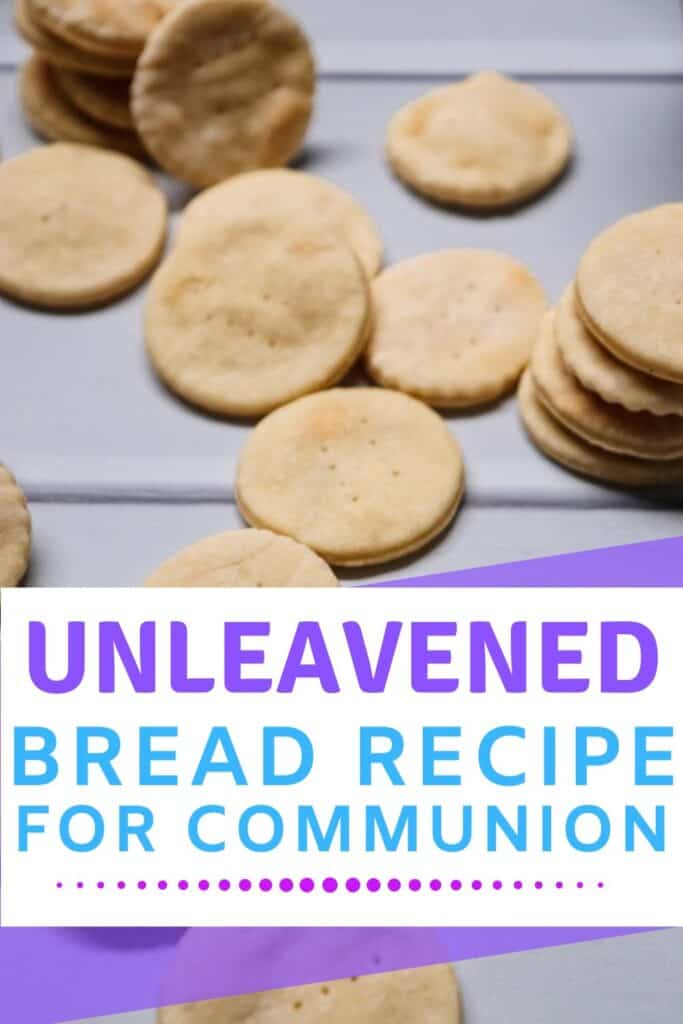


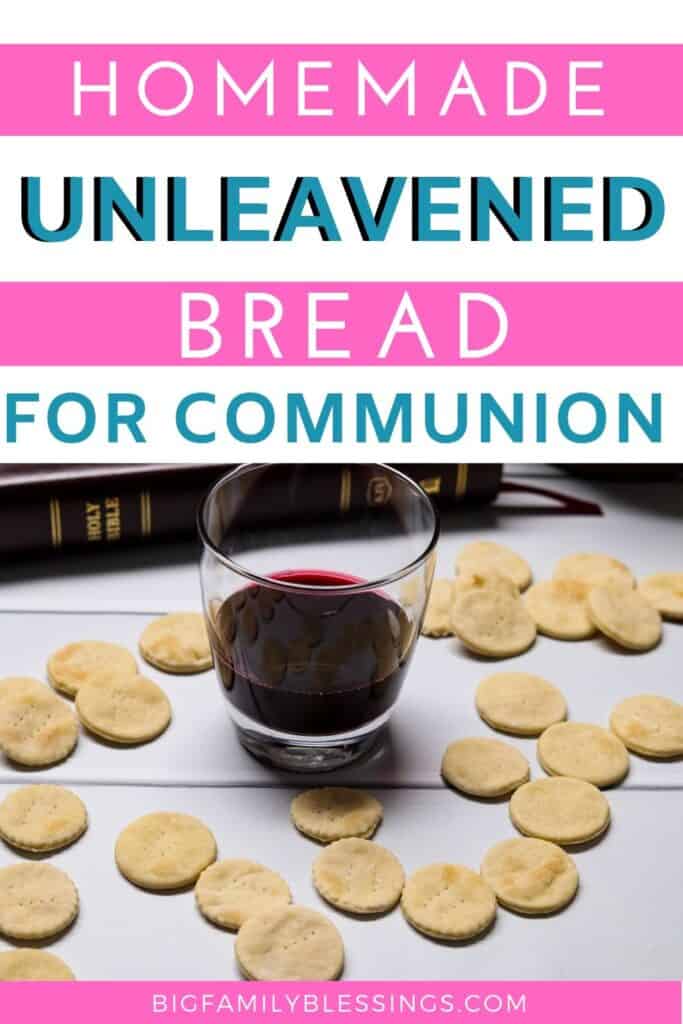








Hey Amanda! I tried your recipe today. Awesome recipe but just one problem. The recipe at the bottom of the page calls for 2 cups of hot water. I ended up with pancake batter consistency and had to add at least 2 additional cups of flour. I added a little more honey, oil, and salt since I added so much more flour. They baked ok and don’t taste too bad but they ended up really tough from I’m guessing all the extra flour and kneading I had to do to get to actual dough 🙂
I found up above it has just one cup listed. Wish I’d seen that before I mixed everything but I just scrolled to the bottom quick for recipe and directions. I will definitely try these again though. Thought I’d let you know so you could fix it. 🙂 Thanks for a great site!
Thanks so much for catching that and letting me know. I’m sorry your recipe didn’t turn out right due to my typo. One cup of water is correct, and I’ve fixed it in the recipe card.
Amanda,
The ingredient list at the top says 2 tsp honey, but at the bottom you have 2 tablespoons honey. Which should it be?
Sorry for that typo! I’ll go fix it now. It should read 2 teaspoons of honey.
I had your mixture all mixed before I read what you said about any cracker will work
That’s not true if it’s unleavened bread it can not have leaven in it snd the crackers do
Unleavened is a biblical word for sin
So I won’t be supporting your blog again
The recipe I provide for unleavened bread on this blog post does not include any leaven (yeast).
I’m eager to make these for communion but have no honey. Is it possible to use sugar in its place? If so, how much would be appropriate? Thank you!
I have never tried this recipe using sugar instead of honey. If you give it a try, please let me know how it turns out! Good luck!
Are they meant to be soft/chewy? We’re used to more “cracker-like” so just checking – have baked twice as long as instructed.
Yes, I think you can expect a softer, chewy bread. If you want it more cracker like, I’d recommend trying to roll it as thin as you can without breakage. You might want to also turn the oven temp up to 450 and cook them for less time. If you try it, I’d love to hear how it goes for you!
Thank you, Amanda. It’s a blessing to spot your recipe. Surprised it’s easy and it’s goes well! The process is amazing. I learn to love God, treasures simple things in life that God has blessed. May God protects each of your family members,in this time every day. With hugs n Love, Victoria Soh, in West of Singapore.
I’m glad this recipe worked well for you! God bless you as well.
Hi, I love this recipe with honey.I kneaded it exactly 3 minutes. This is my second batch. Both seem tough and chewy. Is this the norm ?
Are you rolling the dough out to 1/8 of an inch. You’ll want to get it really thin!
Hi, I cut the receipt into 3rds. It is only my wife and I so I did not need the whole thing. It worked fine, thank you.
I’m glad it worked well for you!
these look great for passsover and the feast of unleavened bread!
Do you use plain or self raising flour
I use plain flour.
To add to Amanda’s reply, self-raising flour has leavening, so would not be unleavened for communion or Passover.
Should these be frozen before or after baking?
I would recommend freezing them after baking, though they may loose their crispness. If you prefer crisp crackers, freeze the ball of dough, then thaw, roll out, cut and bake.
Thank you very useful
Hi Amanda,
I’d like to make this but I’m not sure which type of olive oil to use. Which do you use?
Thanks!
Any type of olive oil should work just fine. I use whatever I have on hand, sitting beside the stove. Usually a generic brand, extra virgin olive oil.
Will this recipe work with whole wheat flour?
This recipe should also work with whole wheat flour. However, I have not tried it myself.
Whole wheat flour typically can lower the rise in a baked good- but since this bread is unleavened I’d think that switching to whole wheat would be fine.
Whole wheat will also make for a stiffer dough, if you feel the dough is too hard to roll out you might need to add a few more drops of water or oil to the mixture.
If you try it, I’d love to hear how it goes!
Hi Amanda, plain flour with a little hot water is the only ingredients that should be used for “unleavened” Communion bread. There shouldn’t be anything else added.
Have a blessed day! DF
If that’s what you prefer, you can make them that way.
Can barley flour be used ?
I have never tried this recipe with Barley flour. Let me know how it goes if you try it!
Heavenly recipe.
Thank you so much, I just finished making it for our Love Feast at our church.
Hello,
I recently learned about unleavened bread and in some of my readings, I noticed that the water used in this recipe should be a certain type of water but didn’t go into any specifics on that. Do you know what that certain type of water is?
You’ll want hot water for the recipe. Tap water is fine.
Finally!!! A communion bread recipe without dairy! I have not tried this but I am wondering if this can be rolled out into a large rectangle, pricked and cut with a pizza cutter for small pieces?
I’m glad this recipe suits your needs! I would think that cutting as you described would work well- and make quick work of the job!